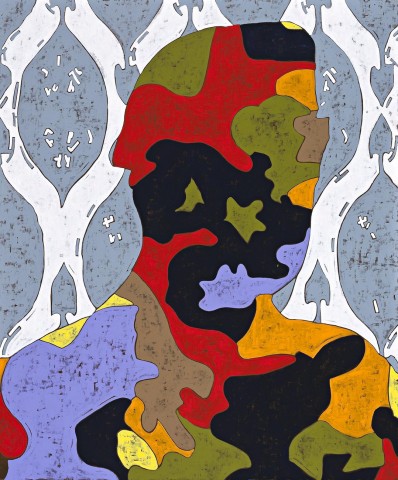CAMOUFLAGE #6, 2003
GORDON BENNETT
synthetic polymer paint on linen
182.5 x 152.0 cm
signed, dated and inscribed with title verso: G Bennett 29 Feb 2003 / “CAMOUFAGE [sic] #6 / …
Sherman Galleries, Sydney (stamped verso)
Gene and Brian Sherman collection, Sydney
Figure/Ground (Zero), Sherman Galleries, Sydney, 17 July – 9 August 2003, cat. 10 (illus. in exhibition catalogue)
Disobedience, Ivan Dougherty Gallery, Sydney, 8 September – 15 October 2005
Hill, P., ‘Zero Hour’, Sydney Morning Herald, Sydney, 2 August 2003
McLean, I., ‘Camouflage’, Figure/Ground (Zero) exhibition catalogue, Sherman Galleries, Sydney, 17 July – 9 August 2003
Camouflage #7, 2003, acrylic on linen, 182.5 x 152 cm, in the collection of the Australian National University, Canberra
Camouflage #8, 2003, acrylic on linen, 182.5 x 152 cm, in the collection of the Australian War Memorial, Canberra
History painting was once considered the most noble of all genres of painting, revered in the 17th century foremost for its ability to document and record for posterity both the events of the past and those of the artist’s lifetime. Gordon Bennett was a painter of history and histories. As a critically and politically engaged artist, Bennett articulated alternative historical narratives of Australia and of contemporary world events, creating provocative works that placed identity politics front and centre. Camouflage #6, 2003 comes from a series of reportage paintings that most clearly displayed Bennett’s brief international focus. Catalysed by political and social anxiety following the 9/11 attacks and the subsequent War on Terror, the series comprises portraits of the late Iraqi dictator Saddam Hussein in army fatigues and of anonymous soldiers wearing gas-masks, their features uniformly mottled and obscured with an overlay of camouflage and decorative patterns.
Shown to critical acclaim in the Figure/Ground (Zero) exhibition at Sherman Galleries, Sydney, the Camouflage works are important historical documents, distilling the artistic and socio-political zeitgeist of the years immediately after the turn of the twentieth century. Created at the height of international paranoia over the existence of biological and chemical weapons of mass destruction, the Camouflage works appropriated a propaganda portrait of Hussein that had been widely distributed by Western media outlets, at a time when the dictator was still in hiding. The confronting impact of these works has inevitably been altered by historical perspective and our knowledge of the subsequent chain of events since they were created. Heavily distorting and masking the features of his subjects with military apparel and abstract patterns, Bennett comments on the ambiguity and subterfuge of political rhetoric around the casus belli of the War on Terror. Ian Mclean, in his essay for the Figure/ Ground (Zero) catalogue, links Bennett’s criticism of political rhetoric to the artist’s long-standing concern with Australian post-colonial perception of indigenous peoples, creating parallels between global and local terror.1 The artist, in a 2003 interview with Bill Wright, explained that the works were about ’colonial dominance’.2
Bennett was a quintessentially post-modern painter. His works employed a unique syntax that mined the vast contemporary visual landscape – appropriating historical works of art and images from mass media –as well as incorporating iconography that was purely the artist’s own. In these works Bennett applies bright colours to the American Woodland military camouflage pattern (used by the US Army from 1981 – 2005) and to devotional Turkish Ogival designs used in Koranic decoration3 to progressively render the once iconic image of the dictator increasingly abstract – in Camouflage #6 only a silhouette remains. Reminiscent of Andy Warhol’s last self-portrait, Camouflage Self-Portrait, 1986, in the collection of the Metropolitan Museum of Art, Bennett’s Camouflage works created a ’veil’ for the dictator, shrouding the figure in secrecy, and as McLean notes, dehumanising his ubiquitous image with the ‘iconoclastic retribution of defeat’.4
1. McLean, I., Camouflage, Figure/Ground (Zero), exhibition catalogue, Sherman Galleries, Sydney, 17 July – 9 August 200
2. The artist in conversation with Bill Wright, cited in Gellatly, K., Gordon Bennett, National Gallery of Victoria, Melbourne, 2007, p. 10
3. Stanhope, Z., ‘Response and Riposte in the Art of Gordon Bennett and Peter Robinson’, Gordon Bennett and Peter Robinson: Three Colours, Institute of Modern Art, Brisbane, 26 April – 4 June 200
4. McLean, I., ibid.
LUCIE REEVES-SMITH
